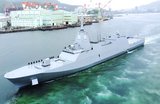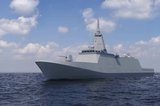Naval Warfare magazine: European forecast, amphibious ships, network defences and more
Read the latest edition of Naval Warfare for free in our app or on your desktop. Register below to be sent the download link and receive future editions direct to your inbox.
Comment
While the high-profile case of the USS Theodore Roosevelt has proved an object exercise in how not to do PR, many further lessons await the world's navies as the COVID-19 crisis unfolds.
Features include:

SHIELDED SYSTEMS
As the cyber domain comes to permeate all areas of military activity, naval vessels need to be designed from the keel up with robust network defences.

THE ART OF THE POSSIBLE
Transforming what was traditionally a single-purpose weapon, future generations of torpedoes could feature multiple detonation modes, function as a defensive capability or even serve a secondary role as ISR nodes.
Other features include:
IN HARM'S WAY
Landing helicopter dock and landing platform dock fleets are now widely regarded as too vulnerable for the amphibious assault role they were designed for. Shephard investigates their potential future task set and what kind of vessel could perform their originally intended mission.
SAVING SUBMARINES
Rescuing crews from a stricken submarine at depth is a challenging task requiring rapid deployment of highly specialised equipment and personnel. Shephard takes an in-depth look at NATO’s joint capability in this area.
OFFSHORE CONSTRUCTION
With the ability to patrol ever further out into territorial waters, and yet cheap enough to procure in quantity, the OPV is becoming the asset of choice for non-combat naval missions.
TROUBLE AHEAD
While many European navies are aiming to refresh their vessel inventories in the next decade, the inevitable impact of COVID-19 on budgets could curtail these efforts.
WESTERN APPROACHES
The Gulf of Guinea and its surrounding waters continue to suffer from elevated levels of piracy and robbery at sea. Shephard examines the causes of the problem and how it might be combated using lessons learned from other parts of the world.
LURED AWAY
Naval soft-kill technology is evolving to counter new and increasingly diverse threats as missiles increase in sophistication.

More from Naval Warfare
-
![Future of the Canadian Patrol Submarine Project is still unclear]()
Future of the Canadian Patrol Submarine Project is still unclear
The Canadian government remains tight-lipped on the timeline and funding required for the next steps of its Canadian Submarine Patrol Project, which should offer improved capabilities for the country’s navy.
-
![Mitsubishi eyes future with Australia’s Mogami selection]()
Mitsubishi eyes future with Australia’s Mogami selection
With Australia’s selection of the Mogami-class for Project Sea 3000, Mitsubishi is investigating local production in the next decade as potential export opportunities emerge.
-
![Thales’ new Sonar 76Nano could equip UK Royal Navy on anti-submarine warfare missions]()
Thales’ new Sonar 76Nano could equip UK Royal Navy on anti-submarine warfare missions
The new sonar is designed to equip uncrewed underwater vessels, with the potential to be used by the Royal Navy for its Atlantic Bastion and Atlantic Net missions.
-
![UK to join US Navy’s Virginia-class submarine assembly effort to speed up construction]()
UK to join US Navy’s Virginia-class submarine assembly effort to speed up construction
The expansion of the Virginia-class submarine construction to UK shores could accelerate the project as US shipbuilders continue to fall short of delivery goals.























